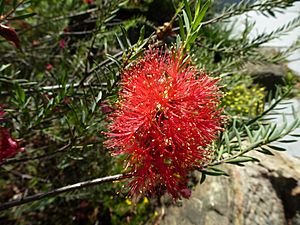Scarlet honey myrtle facts for kids
Quick facts for kids Scarlet honey myrtle |
|
|---|---|
 |
|
| Melaleuca fulgens in Kings Park | |
| Scientific classification | |
| Genus: |
Melaleuca
|
| Species: |
fulgens
|
The Melaleuca fulgens, often called the scarlet honey myrtle, is a beautiful plant. It belongs to the myrtle family called Myrtaceae. This plant is special because it is endemic to certain parts of Australia. You can only find it naturally in Western Australia, South Australia, and the Northern Territory. People love this plant for its bright orange, red, or purple flowers. It also has unique leaves and fruits. It's a popular choice for gardens. The scarlet honey myrtle is part of the Melaleuca group, which includes many different plants, from large trees like M. quinquenervia to small shrubs.
Contents
What the Scarlet Honey Myrtle Looks Like
The scarlet honey myrtle is a woody shrub. It usually grows to be about 1 to 10 feet (0.4 to 3 meters) tall. Its small branches are smooth, meaning they don't have hairs. The leaves grow in a special way: they are arranged in pairs, with each pair at a right angle to the one above and below it. This makes the leaves form four neat rows along the stems.
The leaves are a grey-green color. They are about 0.3 to 1.4 inches (8 to 35 mm) long and 0.03 to 0.2 inches (0.7 to 5.5 mm) wide. Their shape can change a bit depending on the type of plant, but they are usually long and narrow or slightly egg-shaped.
Flowers and Fruit
The flowers of the scarlet honey myrtle can be red, pink, or white. They grow in spikes on the sides of the branches. These flower spikes can be up to 3 inches (75 mm) wide. Each spike has 6 to 20 individual flowers, also arranged in that special four-row pattern.
Inside each flower, there are five groups of stamens (the parts that make pollen). Each group is at least 0.8 inches (20 mm) long and has 22 to 80 tiny stamens. You can see these beautiful flowers from late winter to summer, usually from July to December. After the flowers, the plant produces woody fruits. These fruits are like small capsules, about 0.2 to 0.3 inches (4.2 to 7.2 mm) long. They are shaped like a squashed urn and also grow in alternating pairs along the stems.
Naming the Scarlet Honey Myrtle
The Melaleuca fulgens was first officially described by a botanist named Robert Brown in 1812. He wrote about it in a book called Hortus Kewensis. The second part of its scientific name, fulgens, comes from a Latin word that means "bright-colored" or "shining." This name perfectly describes its eye-catching flowers!
Different Types of Scarlet Honey Myrtle
There are three main types, or subspecies, of Melaleuca fulgens. They are mostly different because of how long their stamen parts are and where they grow:
- M. fulgens R.Br. subsp. fulgens: This type grows in many areas of southwestern Western Australia. It has long, narrow leaves and stamens that are about 0.6 to 1.1 inches (16.5 to 27 mm) long.
- Melaleuca fulgens subsp. steedmanii: This type is found in a smaller area near Geraldton, between Shark Bay and Coorow. It has narrow, egg-shaped leaves and shorter stamens, about 0.5 to 0.7 inches (12 to 18 mm) long.
- Melaleuca fulgens subsp. corrugata: This type grows in separate areas near the border of Western Australia, South Australia, and the Northern Territory.
Where the Scarlet Honey Myrtle Grows
This melaleuca plant is found in a large area across Western Australia. You can see it from Kalbarri down to Kalgoorlie, and south to the coast. It also grows in the border areas with South Australia and the Northern Territory. It likes to grow in sandy or gravelly soils, often near large rock formations made of granite.
Protecting the Scarlet Honey Myrtle
The Government of Western Australia's Department of Parks and Wildlife says that Melaleuca fulgens is "not threatened." This means it's not currently in danger of disappearing.
Growing Scarlet Honey Myrtle in Gardens
People started growing Melaleuca fulgens in gardens in the United Kingdom back in 1803. Today, it's a very popular plant in Australian gardens. There are even some mixed types (hybrids) available.
This plant grows well if it gets enough water, but it needs soil that drains well. If the soil stays too wet, it can get sick from fungus. Gardeners love its pretty grey leaves and bright, showy flowers. Trimming the plant a little helps it produce more flowers and keeps its shape nice.
You can grow new plants from seeds. However, if you want to make sure the new plant has the same flower color and shape as the parent plant, it's better to grow it from semi-mature cuttings (small pieces of the plant). Some types of this plant have lovely apricot-colored flowers.
Related pages
- Melaleuca fulgens subsp. fulgens, commonly known as the scarlet honey myrtle.
- Melaleuca fulgens subsp. steedmanii, endemic to the south-west of Western Australia.
Images for kids
-
M. fulgens growing 10 km S of Tardun



